Objective: Most community-based studies have shown a more malignant clinical course for patients with dementia with Lewy bodies (DLB) than Alzheimer’s disease (AD). We examined differences in outcomes between patients with DLB and AD hospitalized for the treatment of behavioral and psychological symptoms of dementia.
Method: A chart review was conducted of patients with either AD or DLB hospitalized in the acute psychogeriatric ward between January 2008 and December 2011 in Kahoku-City, Ishikawa, Japan. Outcome measures were discharge destinations and time to death. A diagnosis of AD was made according to DSM-5 criteria, whereas a diagnosis of DLB was made according to the Consortium on DLB International Workshop criteria for probable DLB. Pharmacologic treatment was optimized under constant monitoring of patients. Cholinesterase inhibitors and yi-gan san were tried prior to antipsychotics in DLB patients.
Results: The study cohort consisted of 224 patients with AD and 106 with DLB. After matching for sociodemographic factors and cognitive and physical function, it was found that antipsychotics were less frequently used during hospitalization in patients with DLB than AD (63% vs 82%, respectively, P < .01), whereas cholinesterase inhibitors (88% vs 43%, P < .001) and yi-gan san (35% vs 20%, P < .05) were more frequently used in patients with DLB. There were no significant differences in discharge destinations between the 2 groups. The 5-year cumulative survival rates were similar in the AD and DLB groups (46.4% vs 45.7%, respectively, P = .6225).
Conclusions: Optimization of pharmacologic treatment during hospitalization could reduce the use of antipsychotics and improve the subsequent clinical course in DLB.
Outcomes of Inpatient Treatment for Behavioral
and Psychological Symptoms of Dementia in
Alzheimer’s Disease Versus Dementia With Lewy Bodies
ABSTRACT
Objective: Most community-based studies have shown a more malignant clinical course for patients with dementia with Lewy bodies (DLB) than Alzheimer’s disease (AD). We examined differences in outcomes between patients with DLB and AD hospitalized for the treatment of behavioral and psychological symptoms of dementia.
Method: A chart review was conducted of patients with either AD or DLB hospitalized in the acute psychogeriatric ward between January 2008 and December 2011 in Kahoku-City, Ishikawa, Japan. Outcome measures were discharge destinations and time to death. A diagnosis of AD was made according to DSM-5 criteria, whereas a diagnosis of DLB was made according to the Consortium on DLB International Workshop criteria for probable DLB. Pharmacologic treatment was optimized under constant monitoring of patients. Cholinesterase inhibitors and yi-gan san were tried prior to antipsychotics in DLB patients.
Results: The study cohort consisted of 224 patients with AD and 106 with DLB. After matching for sociodemographic factors and cognitive and physical function, it was found that antipsychotics were less frequently used during hospitalization in patients with DLB than AD (63% vs 82%, respectively, P < .01), whereas cholinesterase inhibitors (88% vs 43%, P < .001) and yi-gan san (35% vs 20%, P < .05) were more frequently used in patients with DLB. There were no significant differences in discharge destinations between the 2 groups. The 5-year cumulative survival rates were similar in the AD and DLB groups (46.4% vs 45.7%, respectively, P = .6225).
Conclusions: Optimization of pharmacologic treatment during hospitalization could reduce the use of antipsychotics and improve the subsequent clinical course in DLB.
Prim Care Companion CNS Disord 2015;17(5):doi:10.4088/PCC.15m01785
© Copyright 2015 Physicians Postgraduate Press, Inc.
aDepartment of Neuropsychiatry, Ishikawa Prefectural Takamatsu Hospital, Ya-36, Uchi-Takamatsu, Kahoku-City, Ishikawa, Japan
*Corresponding author: Tatsuru Kitamura, MD, PhD, Department of Neuropsychiatry, Ishikawa Prefectural Takamatsu Hospital, Ya-36, Uchi-Takamatsu, Kahoku-City, Ishikawa, Japan 929-1293 ([email protected]).
Alzheimer’s disease (AD) and dementia with Lewy bodies (DLB) are 2 of the most common types of dementia.1–3 Previous studies have compared disease progression and treatment outcomes between AD and DLB4–13; most studies4–10,13 have reported unfavorable clinical outcomes among patients with DLB, including a greater risk of admission to the medical hospital and shorter survival. One possible explanation for these observations could be vulnerability to neuroleptic sensitivity reactions,14 which are characterized by a sudden onset of sedation and increased confusion and immobility, often leading to fatal consequences.15
It has been demonstrated that some psychiatric symptoms in DLB may respond to cholinesterase inhibitors.16–18 Yi-gan san, a traditional Asian herbal medicine, has also emerged as a safer alternative to antipsychotics for the treatment of psychiatric symptoms and sleep disturbances in DLB.19–21 Nevertheless, a study showed that antipsychotics are still prescribed more frequently to DLB patients despite the risk of neuroleptic sensitivity reactions.22
Most of the studies comparing the clinical course of DLB and AD have been conducted in community-based or outpatient settings, and these sorts of comparisons in hospitalized patients are rare. In Japan, the number of patients admitted to psychiatric hospitals because of behavioral and psychological symptoms of dementia has increased.23 One advantage of inpatient treatment is that pharmacologic treatment can be optimized based on detailed observations of changes in symptoms, as well as signs of adverse reactions, while patients are being closely monitored under specialist care. In the present study, we retrospectively examined differences in outcomes between patients with DLB and AD who had been hospitalized for treatment of behavioral and psychological symptoms of dementia. We hypothesized that inpatient treatment could have a positive impact on the subsequent clinical course of patients with DLB.
METHOD
The medical records of patients who had been hospitalized in the acute psychogeriatric ward of Ishikawa Prefectural Takamatsu Hospital, Kahoku-City, Ishikawa, Japan, were reviewed. The institutional review board approved this retrospective analysis and waived the requirement for written informed consent.
Patients
Consecutive patients with AD and DLB who had been admitted to the acute psychogeriatric ward for treatment of behavioral and psychological symptoms of dementia between January 2008 and December 2011 were enrolled in the study. All patients had severe behavioral and psychological symptoms of dementia such that they could not be cared for in their own home or care facility, nor could they be treated in an outpatient setting. Patients with significant comorbid physical disease were judged to be ineligible for hospitalization to the acute psychogeriatric ward in order to prioritize medical treatment for their physical problems. Patients who had primary neurologic or psychiatric disease other than AD and DLB, and those who had behavioral symptoms prior to cognitive decline, were excluded from the study. Patients with a history of hospitalization in the acute psychogeriatric ward of Ishikawa Prefectural Takamatsu Hospital were also excluded from the study.
Measures
In all patients, the following items were evaluated and recorded within 1 week of admission according to institutional protocol.
Demographics
Data regarding the patient’s gender, age, living situation (including residency and family style before hospitalization), and relationship with his/her caregiver were obtained from an interview or a questionnaire administered by a psychiatric social worker to the family members or staff of the care facility or hospital. Residency before hospitalization was classified as the patient’s own home, group home, care facility, or medical hospital. A group home is a care facility wherein a group of people live their daily lives essentially independently, with staff support only when needed. Family style refers to the people with whom the patient had lived. In the case of patients who had lived with family members other than their partner or with staff of a care facility, group home, or medical hospital, family style was classified as “other.” The relationship with the caregiver was classified as partner, other family member, or staff.
Type of Dementia
A diagnosis of dementia was made by either of 2 experienced geriatric psychiatrists (T.K. and M.K.) based on an interview with the patients and family members or staff, physical and neurologic findings, laboratory data, and brain imaging. A diagnosis of AD was made according to the DSM-5, whereas diagnoses of DLB were made according to the Consortium on DLB International Workshop criteria for probable DLB.1,24
Primary Reason for Hospitalization
The behavioral problems causing distress to the caregiver and that were the primary reasons for hospitalization were recorded following interviews with the caregiver. Primary reasons for hospitalization were classified as combative behavior, overactivity, or apathy/depression. Combative behavior comprised physically or verbally aggressive behavior during or between care provision, such as hitting, kicking, biting, throwing things, cursing, and screaming. Overactivity included nonaggressive behavior that required monitoring, such as aimless wandering, trying to reach a different place, restlessness, or repetitive actions and mannerisms. Apathy/depression included serious apathetic or depressive behavior, such as severe loss of appetite, refusal to eat, refusal to take medication, or suicidal tendencies.25
Behavioral and Psychiatric Symptoms
Behavioral and psychiatric symptoms were evaluated by 2 geriatric psychiatrists (T.K. and M.K.) using the Behavioral Pathology in Alzheimer’s Disease (BEHAVE-AD) rating scale.26 The presence or absence of symptoms in each of 7 clusters comprising a subscale of BEHAVE-AD were recorded, including paranoid and delusional ideation, hallucinations, aggressiveness, activity disturbances, diurnal rhythm disturbances, affective disturbances, and anxieties or phobias.
Cognitive Function
Cognitive function was assessed by the geriatric psychiatrists in the acute psychogeriatric ward using the Mini-Mental State Examination (MMSE).27
Functional State of Daily Living
Activities of daily living (ADL) were scored by well-trained nursing staff according to the Nishimura Activities of Daily Living (N-ADL) scale,28 which is one of the most used scales for the evaluation of ADL in Japan. In the N-ADL, 5 items are evaluated: walking/sitting, range of activities, dressing/bathing, eating, and excretion. Each item is scored from 0 to 10 points, with the total (maximum score 50) taken as the N-ADL score. A higher score indicates better functioning in ADL. Nursing staff rated the reliability of the scale when completed as good.28
Intervention and Monitoring
Nonpharmacologic approaches. Nonpharmacologic approaches were implemented for all patients following admission. In addition to the aforementioned evaluation, medical, psychological, and environmental assessments were conducted to identify modifiable factors that could potentially exacerbate behavioral and psychological symptoms of dementia. We evaluated the presence of pain, inadequate nutrition, infection, and other medical problems. The medication profile for each patient was also reviewed. Interviews were conducted with each patient and key informants to elucidate changes in daily activities and roles at home, previous interests, personality traits, inappropriate coping and communication by caregivers (eg, yelling, harsh tone, criticizing), and the use of care resources. Based on the outcomes of these assessments, we tried to eliminate any conditions identified as contributing to behavioral and psychological symptoms of dementia. Occupational therapy was provided to patients to help them engage in meaningful or pleasurable activities, tapping into preserved capabilities or previous interests. We also provided education to the caregivers to improve their understanding of the disease and their communication with the patient.
Pharmacologic interventions. The principles of our pharmacologic approach were as follows. After comprehensive assessment and symptom observation in the first week, patients received pharmacologic intervention based on clinical indications. For DLB patients, cholinesterase inhibitors were tried first. If the cholinesterase inhibitor was not sufficiently effective, yi-gan san was added. Quetiapine was initiated at a low dose (eg, 12.5 or 25 mg/d) and slowly titrated if the combination of the cholinesterase inhibitor and yi-gan san was ineffective or if more acute symptom control of behavior was required. When sensitivity reactions were observed, quetiapine was tapered to a lower dose or discontinued. Switching to other antipsychotics was minimized. For patients with AD, the use of cholinesterase inhibitors and yi-gan san was left to the discretion of individual psychiatrists. The use of quetiapine in patients with AD followed the strategy used in the case of DLB. The use of antidepressants, mood stabilizers, and hypnotics was allowed in both AD and DLB patients.
Monitoring. The nursing staff provided 24-hour care and monitored the patients’ condition under a 3-shift system. Careful attention was paid particularly to the patients’ ability to walk and eat, as well as their ability to concentrate on daily living activities and to detect signs of neuroleptic sensitivity reactions, including extrapyramidal symptoms and cognitive fluctuation. A psychiatrist was present throughout the day shift at the acute psychogeriatric ward, and each patient was examined by a psychiatrist multiple times a day in a regular and timely manner. Daily meetings were held to share information between professionals.
Mortality Surveillance
As part of routine practice, we inspect daily the death notices in the local newspaper Hokkoku Shimbun to monitor the incidence of death among patients treated at the Ishikawa Prefectural Takamatsu Hospital. The death notices in Hokkoku Shimbun provide a person’s name and address, date of death, and information on funeral or memorial services. A death notice is submitted by the municipal office to Hokkoku Shimbun every time a municipal resident dies. The newspaper offers to publish death notices for free to the bereaved family. We have confirmed with the Hokkoku Shimbun office that only rarely do families refuse the offer of publication of a death notice.
Statistical Analysis
The main clinical endpoints in the present study were (1) discharge destinations and (2) time to death. Other endpoints included psychotropic medications prescribed during hospitalization and time to discharge.
Data management and statistical calculations were performed using Stata version 11.0 (Statacorp, College Station, Texas). In the case of descriptive statistics, differences between AD and DLB were tested using a t test for age, MMSE score, N-ADL score, and dose of antipsychotics. The χ2 test was used to analyze frequency data.
To enable proper comparisons, the 2 groups (AD vs DLB) were matched for demographic and environmental factors, as well as cognitive and physical state. We used propensity score matching methods29 to produce matched pairs for the AD and DLB groups. To estimate the propensity scores, age, sex, residency before hospitalization, family style, caregiver’s relationship to the patient, MMSE score, and N-ADL score were used as covariates of exposure (DLB) in a logistic regression model. Propensity score estimation and matching were performed using the Stata PSMATCH2 program. Patients with DLB were matched with AD patients on the basis of estimated propensity scores using the nearest neighbor approach within a caliper of 0.02. After matching on propensity scores, the Wilcoxon signed rank test was used to test the significance of differences in age, MMSE score, N-ADL score, and dose of antipsychotics, whereas the McNemar test or multinomial logistic regression analysis was used to analyze differences in frequencies.
Estimates of hospital stay probability were calculated according to Kaplan-Meier methods with the time from admission to discharge. Death during hospitalization or transfer to a medical hospital due to deterioration of a patient’s physical condition was treated as a censor. A log rank test was used to evaluate the differences in time to discharge. In survival analysis, Kaplan-Meier estimation was used with time from admission to death, and the log rank test was used to test the significance of differences. No observed death until the study end was treated as a censor. We also performed multivariate analysis to determine covariates with an effect on time to death. In addition to the type of dementia (AD or DLB), the variables used to construct propensity scores were included in the multivariate Cox proportional hazards model. In this model, backward elimination was used to establish a cutoff P value of .10.
Statistical significance was defined as 2-tailed P < .05. Bonferroni correction was used to adjust P values for multiple comparisons.
RESULTS
Before Matching
In all, 330 patients were identified as eligible for the study: 224 with AD and 106 with DLB. The demographic characteristics and clinical manifestations before matching are listed in Table 1. The 2 groups were similar in age, gender, residency before hospitalization, family style, and caregiver relationship. Regarding cognitive and physical function, although DLB patients had a higher MMSE score, they did not differ from AD patients in terms of the N-ADL score. Combative behavior was more frequently the primary reason for hospitalization of AD patients, whereas overactivity was more frequently the reason for DLB patients. Regarding behavioral and psychological symptoms of dementia, DLB patients were more likely to present with hallucinations, whereas AD patients were more likely to present with aggressiveness.
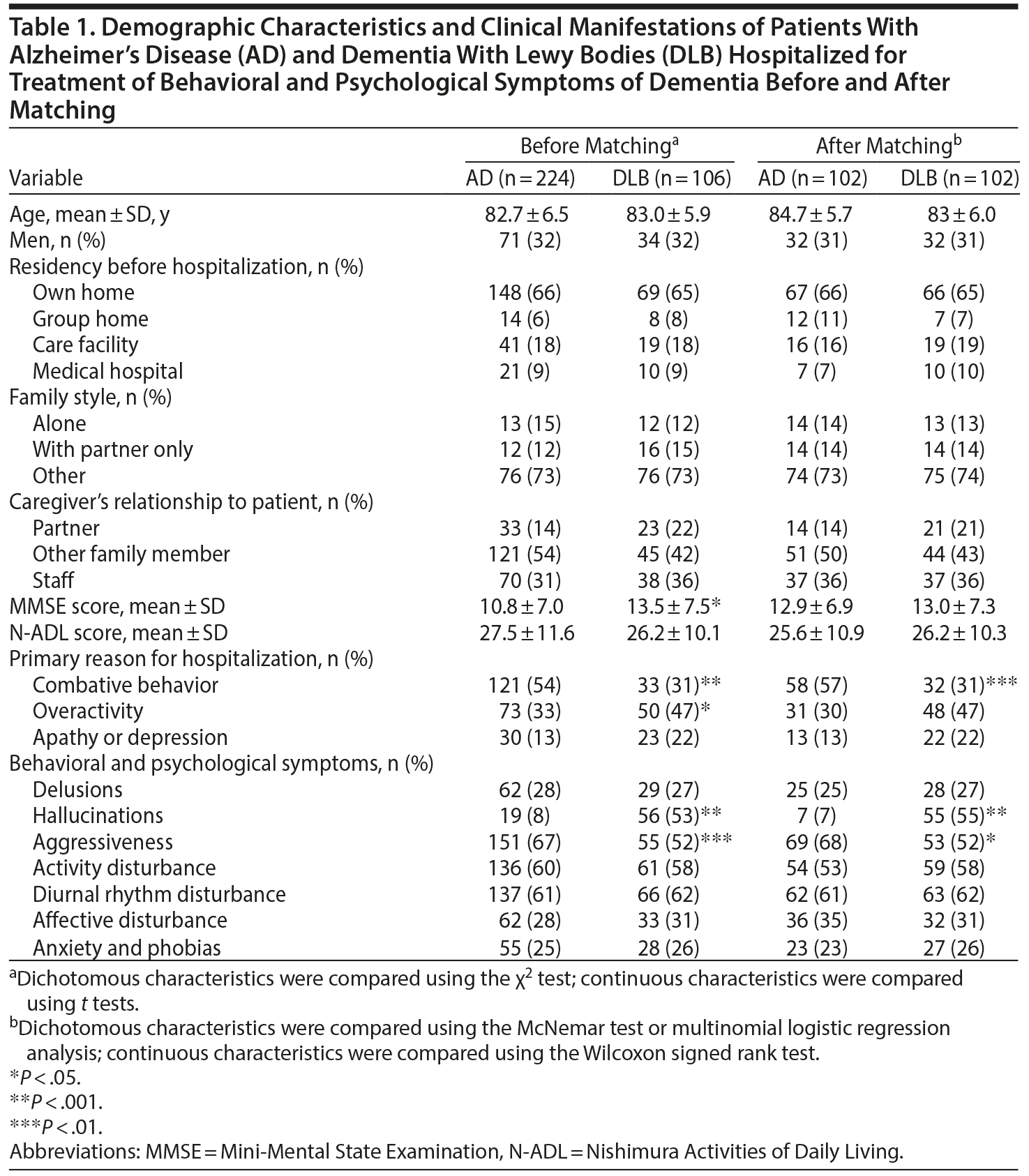
With regard to psychotropic medications prescribed during hospitalization (Table 2), the data before matching showed a less frequent use of antipsychotics, but a more frequent use of cholinesterase inhibitors and yi-gan san in DLB patients. There was no difference in the daily dose of antipsychotics. In AD patients, the types of antipsychotics most frequently used during hospitalization were quetiapine (in 139 patients, 82%), followed by risperidone (22, 13%), olanzapine (10, 6%), and haloperidol (8, 5%). In DLB patients, quetiapine was the most frequently used antipsychotic (in 63 patients, 95%), followed by risperidone (2, 4%) and haloperidol (2, 4%) and olanzapine (1, 1%) and aripiprazole (1, 1%).
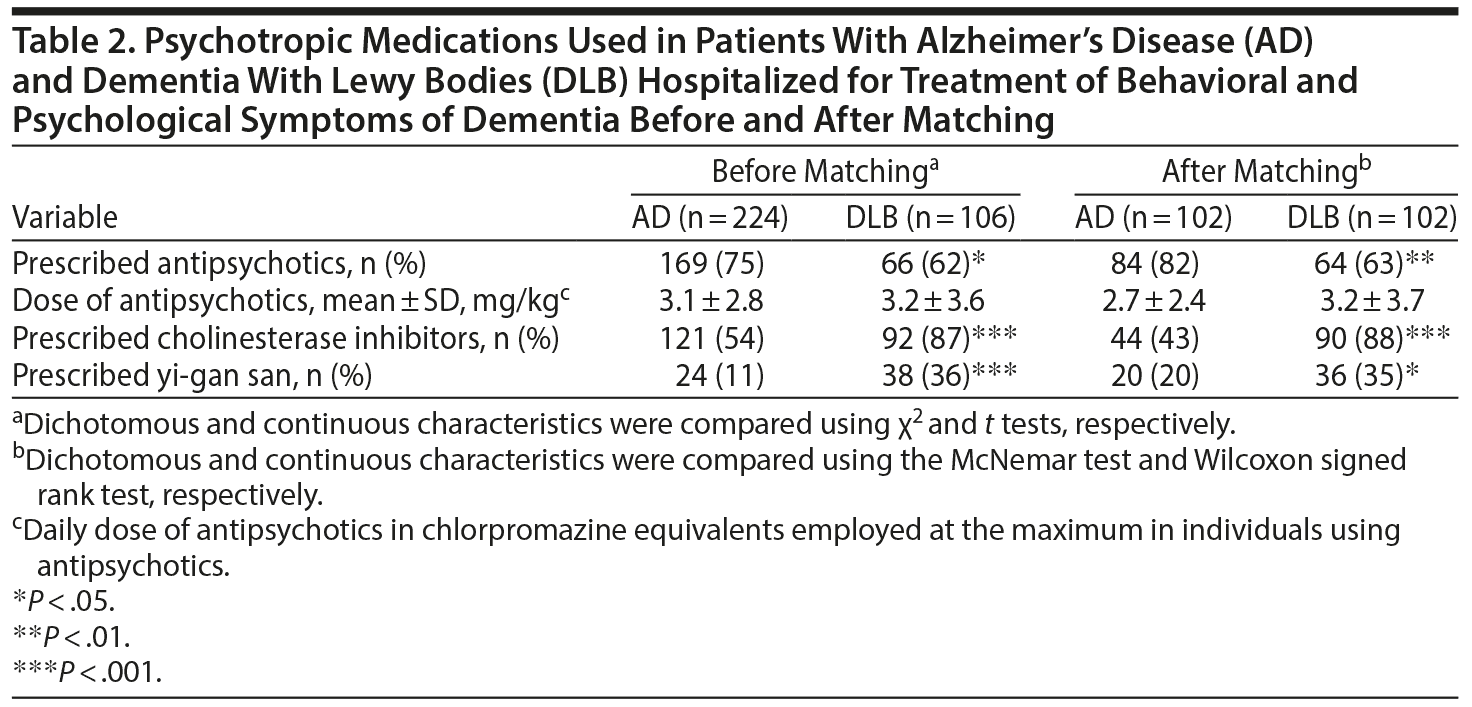
Table 3 lists the discharge destinations of the 2 groups. There were no significant differences in the incidence of discharge to a patient’s own home, group home, care facility, or medical hospital or death during hospitalization between the 2 groups. Kaplan-Meier analysis (Figure 1A) revealed that the length of hospital stay (LOS) was equivalent between AD and DLB patients (median [95% CI] LOS: 77 days [70–84 days] vs 77 days [66–89 days], respectively, P = .7579). Kaplan-Meier analysis on cumulative survival probability is shown in Figure 2A. There was no significant difference in time to death between AD and DLB patients (5-year cumulative survival probability [95% CI] from admission: 56.1% [48.7%–62.8%] vs 45.7% [34.5%–56.2%], respectively, P = .3261).
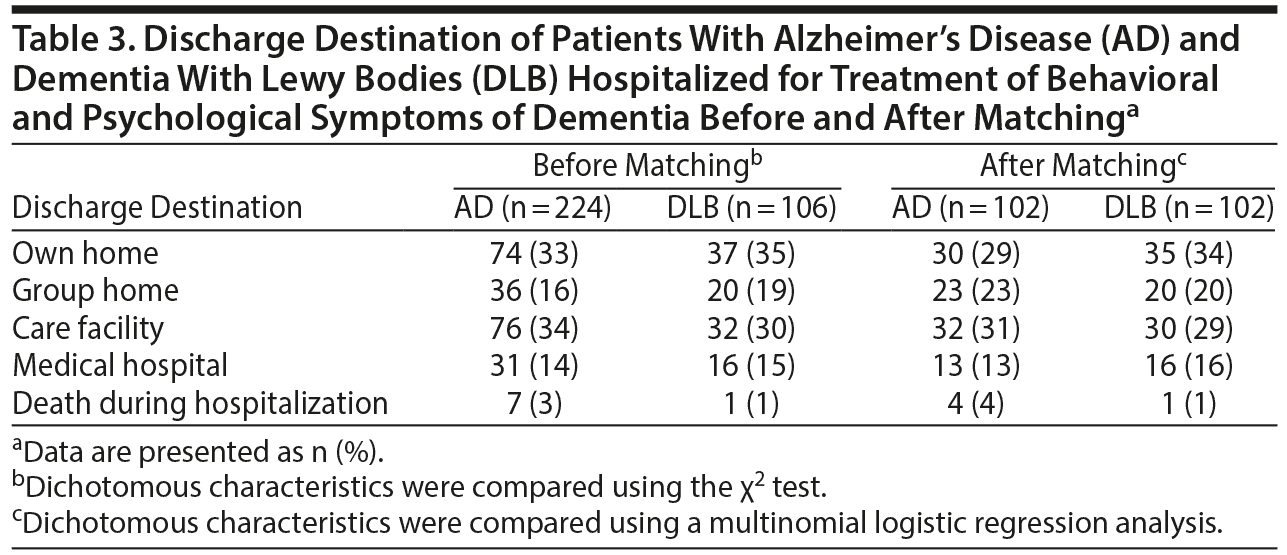
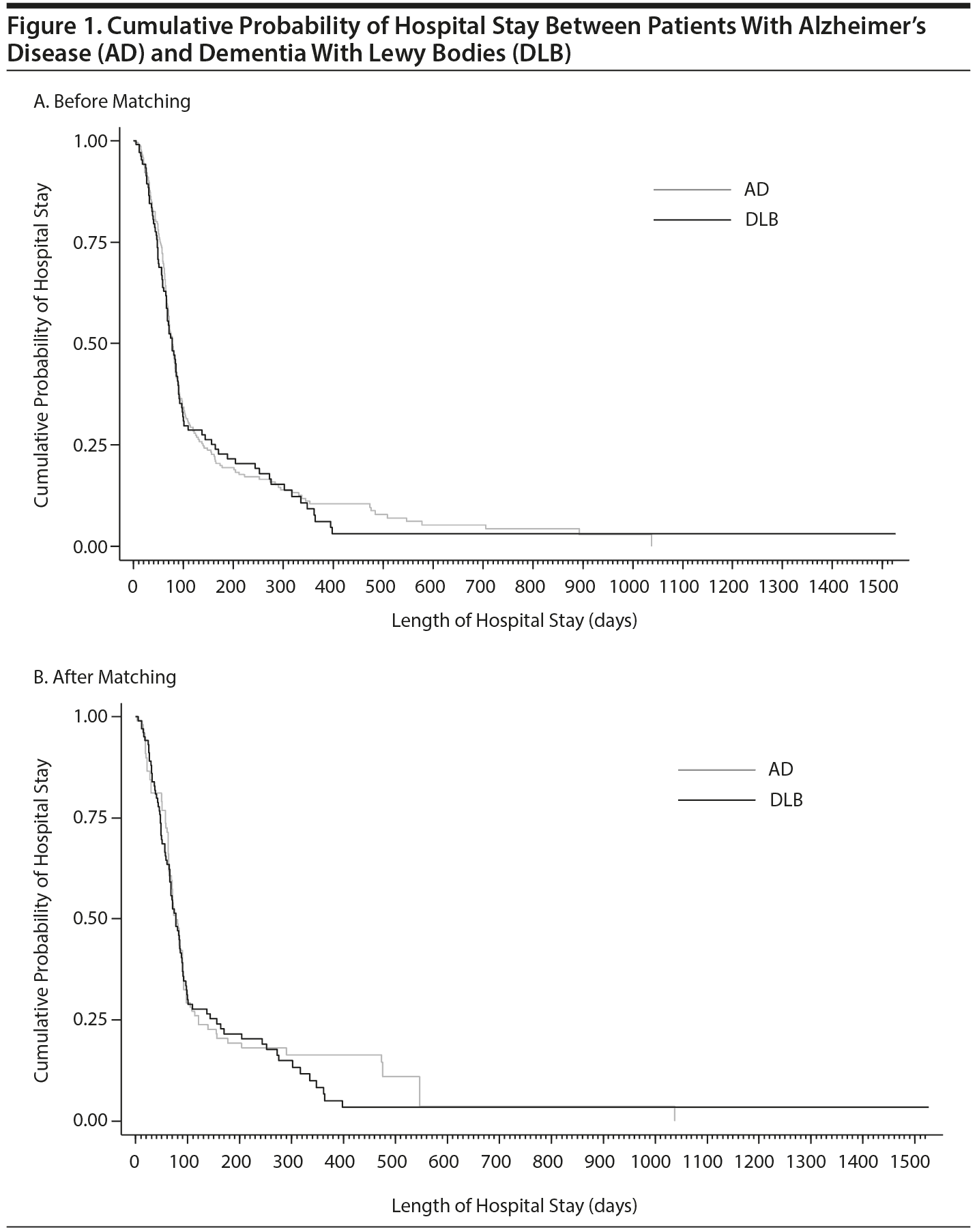
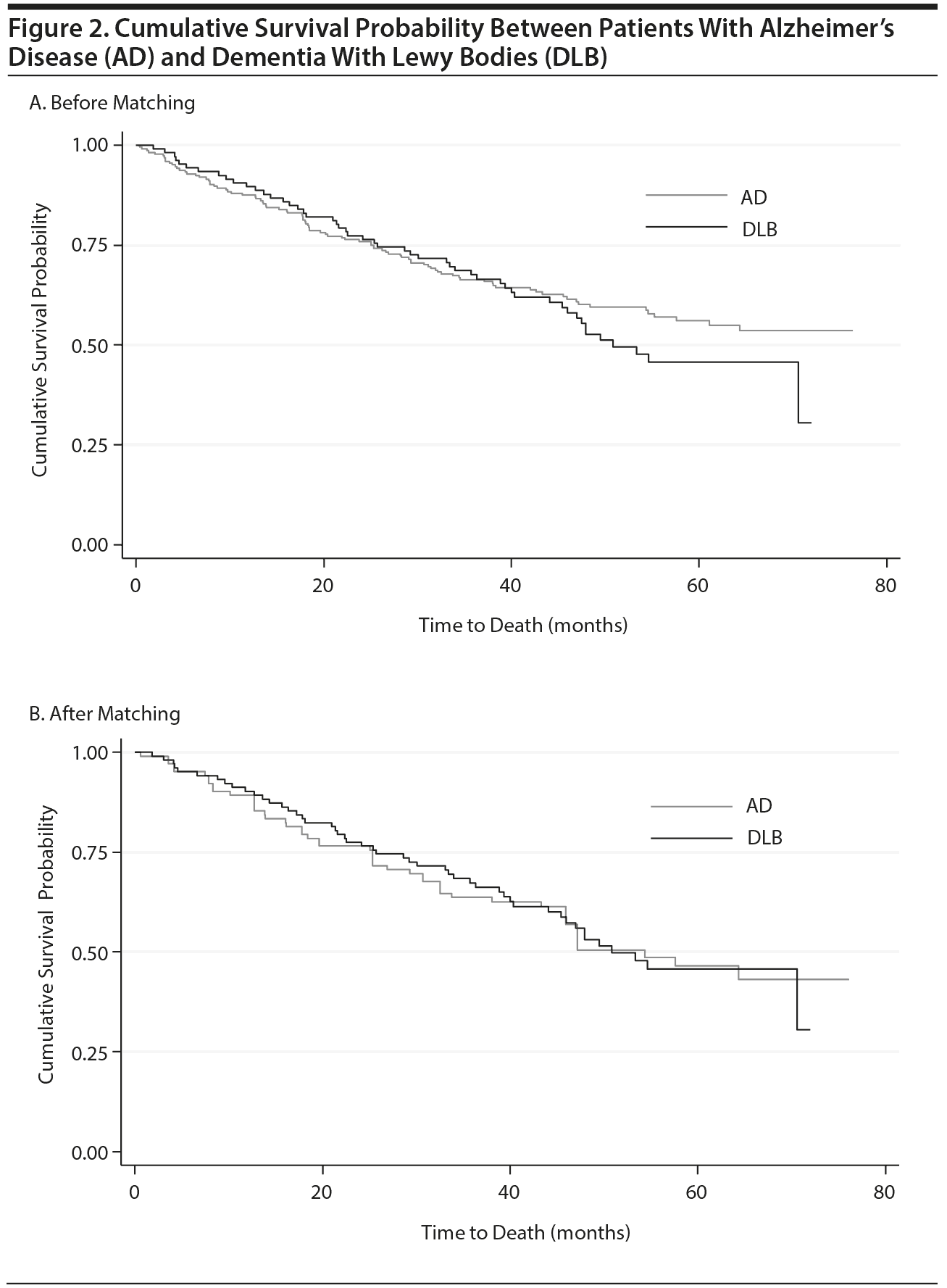
After Matching
Matching on propensity score resulted in 102 matched pairs. Demographic characteristics and clinical manifestations after matching are listed in Table 1 and indicate that the 2 groups were balanced in terms of age, gender, residency before hospitalization, family style, caregiver’s relationship to the patient, N-ADL score, and MMSE score. Even after matching, combative behavior was more frequently the reason for hospitalization of AD patients, whereas the difference in the prevalence of overactivity disappeared between the 2 groups. Among behavioral and psychological symptoms of dementia, the predominance of hallucinations in DLB patients and aggressiveness in AD patients persisted. As seen before matching, antipsychotics were less frequently used in DLB patients, whereas cholinesterase inhibitors and yi-gan san were more frequently used (Table 2).
The incidence of discharge to each destination was similar between the 2 groups (Table 3). The LOS was equivalent between AD and DLB patients (median [95% CI] LOS: 77 days [65–90 days] vs 77 days [66–89 days], respectively, P = .9136, Figure 1B). There was no significant difference in time to death between AD and DLB patients (5-year cumulative survival probability [95% CI]: 46.4% [34.9%–57.2%] vs 45.7% [34.2%–56.5%], respectively, P = .6225, Figure 2B).
Effects of DLB on Time to Death
Multivariate analysis using Cox proportional hazards model identified age, male gender, and N-ADL score as variables independently associated with time to death (for age, hazard ratio [HR] [95% CI] = 1.08 per year increase [1.05–1.11], P = .000; for male gender, HR = 2.97 [2.10–4.19], P = .000; for N-ADL score, HR = 0.98 per unit increase [0.97–1.00], P = .014). DLB was not independently associated with time to death.
DISCUSSION
The results of the present study demonstrate that the outcomes of DLB patients after admission for the treatment of behavioral and psychological symptoms of dementia do not differ from those of AD patients. This finding is inconsistent with the results reported by most community-based studies,1,5–10,13 which found a more malignant clinical course for DLB patients.
In contrast with the results of the population-based studies, we were able to prescribe antipsychotics less frequently to DLB patients, which potentially lowered the risk of neuroleptic sensitivity reactions. As part of our treatment policy to reduce the use of antipsychotics, cholinesterase inhibitors and yi-gan san were used preferentially in DLB patients. Furthermore, the inpatient setting allowed constant monitoring of patients under specialist care, so that signs of neuroleptic sensitivity reactions could be detected and antipsychotics tapered or discontinued accordingly. In the community, levels of knowledge and clinical experience with DLB vary considerably among care practitioners. Signs of neuroleptic sensitivity reactions are often unrecognized or even interpreted wrongly as a deterioration of primary symptoms. These signs may not be observed even by experienced clinicians during brief consultations with patients.30
Regarding behavioral and psychological symptoms of dementia, the present study showed a higher prevalence of aggressiveness in AD than DLB patients, which could be associated with more frequent use of antipsychotics in AD. This finding is attributed to the fact that most AD patients who do not exhibit aggressiveness can be managed within community care systems, which, in Japan, were originally established with the intent of caring for those with AD.
In the present study, survival time was estimated from the time of hospital admission, whereas the majority of previous studies estimated survival from disease onset or from the time of diagnosis. The apparent discrepancy between the present and previous studies may be due to methodological differences. However, the validity of estimating survival from disease onset or diagnosis has been questioned because demented patients and their caregivers often have difficulties pinpointing precisely when the symptoms appeared13,31; difficulties typically emerge gradually and can be subtle for months or even years before the initial hospital visit.13 Stubendorff et al13 proposed the validity of using a certain cognitive level as the benchmark in a survival study. In view of these considerations, we matched AD and DLB patients in terms of their MMSE scores in addition to environmental factors or physical state.
The present study has several limitations that should be acknowledged. Because of the retrospective nature of the study, the information available was limited. In particular, we did not use detailed measures, such as the Dementia Cognitive Fluctuation Scale32 or the Unified Parkinson’s Disease Rating Scale,33 to evaluate the incidence and severity of neuroleptic sensitivity reactions. Although it is generally known that most common causes of death in DLB patients include aspiration pneumonia and fall-related injury,10 which are closely associated with neuroleptic sensitivity reactions, the cause of death for the patients in the present study was not available. Furthermore, we implemented nonpharmacologic approaches in both AD and DLB patients, and this potentially ameliorated some of the symptoms. However, the effect was not systematically evaluated. Finally, this study was conducted in a particular region in Japan. Thus, the generalizability of the results could be questioned. A future well-designed, multicenter study could be warranted to confirm the findings reported herein.
In conclusion, the outcomes for DLB patients after admission for the treatment of behavioral and psychological symptoms of dementia are comparable to those of AD patients. This finding could be attributed to optimization of pharmacologic treatment under close monitoring by specialists during the period of hospitalization. The findings of the present study also highlight the importance of providing care practitioners in the community with a correct understanding of DLB and its neuroleptic sensitivity reactions.
Drug names: aripiprazole (Abilify), haloperidol (Haldol and others), olanzapine (Zyprexa), quetiapine (Seroquel), risperidone (Risperdal and others).
Submitted: January 14, 2015; accepted May 1, 2015.
Published online: October 1, 2015.
Potential conflicts of interest: None reported.
Funding/support: None reported.
REFERENCES
1. McKeith IG, Galasko D, Kosaka K, et al. Consensus guidelines for the clinical and pathologic diagnosis of dementia with Lewy bodies (DLB): report of the Consortium on DLB International Workshop. Neurology. 1996;47(5):1113–1124. doi:10.1212/WNL.47.5.1113 PubMed
2. Drach LM, Steinmetz HE, Wach S, et al. High proportion of dementia with Lewy bodies in the postmortems of a mental hospital in Germany. Int J Geriatr Psychiatry. 1997;12(3):301–306. doi:10.1002/(SICI)1099-1166(199703)12:3<301::AID-GPS482>3.0.CO;2-W PubMed
3. Barker WW, Luis CA, Kashuba A, et al. Relative frequencies of Alzheimer disease, Lewy body, vascular and frontotemporal dementia, and hippocampal sclerosis in the State of Florida Brain Bank. Alzheimer Dis Assoc Disord. 2002;16(4):203–212. doi:10.1097/00002093-200210000-00001 PubMed
4. Magierski R, Kłoszewska I, Sobów TM. The influence of vascular risk factors on the survival rate of patients with dementia with Lewy bodies and Alzheimer disease. Neurol Neurochir Pol. 2010;44(2):139–147. PubMed
5. Lopez OL, Wisniewski S, Hamilton RL, et al. Predictors of progression in patients with AD and Lewy bodies. Neurology. 2000;54(9):1774–1779. doi:10.1212/WNL.54.9.1774 PubMed
6. Williams MM, Xiong C, Morris JC, et al. Survival and mortality differences between dementia with Lewy bodies vs Alzheimer disease. Neurology. 2006;67(11):1935–1941. doi:10.1212/01.wnl.0000247041.63081.98 PubMed
7. Olichney JM, Galasko D, Salmon DP, et al. Cognitive decline is faster in Lewy body variant than in Alzheimer’s disease. Neurology. 1998;51(2):351–357. doi:10.1212/WNL.51.2.351 PubMed
8. Armstrong TP, Hansen LA, Salmon DP, et al. Rapidly progressive dementia in a patient with the Lewy body variant of Alzheimer’s disease. Neurology. 1991;41(8):1178–1180. doi:10.1212/WNL.41.8.1178 PubMed
9. Galvin JE. Dementia with Lewy bodies. Arch Neurol. 2003;60(9):1332–1335. doi:10.1001/archneur.60.9.1332 PubMed
10. Hanyu H, Sato T, Hirao K, et al. Differences in clinical course between dementia with Lewy bodies and Alzheimer’s disease. Eur J Neurol. 2009;16(2):212–217. doi:10.1111/j.1468-1331.2008.02388.x PubMed
11. Heyman A, Fillenbaum GG, Gearing M, et al. Comparison of Lewy body variant of Alzheimer’s disease with pure Alzheimer’s disease: Consortium to Establish a Registry for Alzheimer’s Disease, part XIX. Neurology. 1999;52(9):1839–1844. doi:10.1212/WNL.52.9.1839 PubMed
12. Walker Z, Allen RL, Shergill S, et al. Three years survival in patients with a clinical diagnosis of dementia with Lewy bodies. Int J Geriatr Psychiatry. 2000;15(3):267–273. doi:10.1002/(SICI)1099-1166(200003)15:3<267::AID-GPS107>3.0.CO;2-7 PubMed
13. Stubendorff K, Hansson O, Minthon L, et al. Differences in survival between patients with dementia with Lewy bodies and patients with Alzheimer’s disease—measured from a fixed cognitive level. Dement Geriatr Cogn Disord. 2011;32(6):408–416. doi:10.1159/000335364 PubMed
14. McKeith I, Fairbairn A, Perry R, et al. Neuroleptic sensitivity in patients with senile dementia of Lewy body type. BMJ. 1992;305(6855):673–678. doi:10.1136/bmj.305.6855.673 PubMed
15. Aarsland D, Perry R, Larsen JP, et al. Neuroleptic sensitivity in Parkinson’s disease and parkinsonian dementias. J Clin Psychiatry. 2005;66(5):633–637. doi:10.4088/JCP.v66n0514 PubMed
16. Simard M, van Reekum R. The acetylcholinesterase inhibitors for treatment of cognitive and behavioral symptoms in dementia with Lewy bodies. J Neuropsychiatry Clin Neurosci. 2004;16(4):409–425. doi:10.1176/jnp.16.4.409 PubMed
17. Fujita Y, Takebayashi M. Efficacy of low-dose donepezil for visual hallucinations in a patient with dementia with Lewy bodies. Psychiatry Clin Neurosci. 2010;64(3):336. doi:10.1111/j.1440-1819.2010.02088.x PubMed
18. McKeith I, Del Ser T, Spano P, et al. Efficacy of rivastigmine in dementia with Lewy bodies: a randomized, double-blind, placebo-controlled international study. Lancet. 2000;356(9247):2031–2036. doi:10.1016/S0140-6736(00)03399-7 PubMed
19. Shinno H, Utani E, Okazaki S, et al. Successful treatment with yi-gan san for psychosis and sleep disturbance in a patient with dementia with Lewy bodies. Prog Neuropsychopharmacol Biol Psychiatry. 2007;31(7):1543–1545. doi:10.1016/j.pnpbp.2007.07.002 PubMed
20. Mizukami K, Asada T, Kinoshita T, et al. A randomized cross-over study of a traditional Japanese medicine (kampo), yokukansan, in the treatment of the behavioral and psychological symptoms of dementia. Int J Neuropsychopharmacol. 2009;12(2):191–199. doi:10.1017/S146114570800970X PubMed
21. Kung FC, Ishii R, Liu HC, et al. New possibility of traditional Chinese and Japanese medicine as treatment for behavioral and psychiatric symptoms in dementia. Clin Interv Aging. 2012;7:393–396. PubMed
22. Calvó-Perxas L, de Eugenio RM, Marquez-Daniel F, et al; Registry of Dementias of Girona Study. Profile and variables related to antipsychotic consumption according to dementia subtypes. Int Psychogeriatr. 2012;24(6):940–947. doi:10.1017/S1041610212000026 PubMed
23. Reports from the investigative commission on mental health and welfare in the future [in Japanese]. Japanese Ministry of Health, Labor and Welfare. http://www.mhlw.go.jp/shingi/2009/05/s0521-3.html. Accessed June 23, 2015.
24. McKeith IG, Dickson DW, Lowe J, et al; Consortium on DLB. Diagnosis and management of dementia with Lewy bodies: third report of the DLB Consortium. Neurology. 2005;65(12):1863–1872. doi:10.1212/01.wnl.0000187889.17253.b1 PubMed
25. Kitamura T, Kitamura M, Hino S, et al. Gender differences in clinical manifestations and outcomes among hospitalized patients with behavioral and psychological symptoms of dementia. J Clin Psychiatry. 2012;73(12):1548–1554. doi:10.4088/JCP.11m07614 PubMed
26. Reisberg B, Borenstein J, Salob SP, et al. Behavioral symptoms in Alzheimer’s disease: phenomenology and treatment. J Clin Psychiatry. 1987;48(suppl 48):9–15. PubMed
27. Folstein MF, Folstein SE, McHugh PR. “Mini-mental state”: a practical method for grading the cognitive state of patients for the clinician. J Psychiatr Res. 1975;12(3):189–198. doi:10.1016/0022-3956(75)90026-6 PubMed
28. Nishimura T, Kobayashi T, Hariguchi S, et al. Scales for mental state and daily living activities for the elderly: clinical behavioral scales for assessing demented patients. Int Psychogeriatr. 1993;5(2):117–134. doi:10.1017/S1041610293001462 PubMed
29. Oakes JM, Johnson PJ. Propensity score matching methods for social epidemiology. In: Oakes JM, Kaufman JS, eds. Methods in Social Epidemiology. San Francisco, CA: Jossey-Bass; 2006:364–386.
30. Galvin JE, Duda JE, Kaufer DI, et al. Lewy body dementia: the caregiver experience of clinical care. Parkinsonism Relat Disord. 2010;16(6):388–392. doi:10.1016/j.parkreldis.2010.03.007 PubMed
31. Guhne U, Matschinger H, Angermeyer MC, et al. Incident dementia cases and mortality: results of the leipzig Longitudinal Study of the Aged (LEILA75+). Dement Geriatr Cogn Disord. 2006;22(3):185–193. doi:10.1159/000094786 PubMed
32. Lee DR, McKeith I, Mosimann U, et al. The Dementia Cognitive Fluctuation Scale: a new psychometric test for clinicians to identify cognitive fluctuations in people with dementia. Am J Geriatr Psychiatry. 2014;22(9):926–935. doi:10.1016/j.jagp.2013.01.072 PubMed
33. Goetz CG, Tilley BC, Shaftman SR, et al; Movement Disorder Society UPDRS Revision Task Force. Movement Disorder Society–sponsored revision of the Unified Parkinson’s Disease Rating Scale (MDS-UPDRS): scale presentation and clinimetric testing results. Mov Disord. 2008;23(15):2129–2170. doi:10.1002/mds.22340 PubMed
Please sign in or purchase this PDF for $40.00.
Save
Cite
